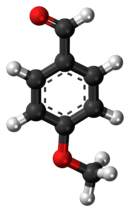4-Anisaldehyde
| |||
| Names | |||
|---|---|---|---|
| IUPAC name
4-Methoxybenzaldehyde | |||
| Identifiers | |||
| 123-11-5 | |||
| 3D model (Jmol) | Interactive image | ||
| ChEMBL | ChEMBL161598 | ||
| ChemSpider | 28984 21105937 | ||
| ECHA InfoCard | 100.004.185 | ||
| PubChem | 31244 | ||
| UNII | 9PA5V6656V | ||
| |||
| |||
| Properties | |||
| C8H8O2 | |||
| Molar mass | 136.15 g/mol | ||
| Density | 1.119 g/cm3 at 15 °C | ||
| Melting point | 0 °C (32 °F; 273 K) | ||
| Boiling point | 248 °C (478 °F; 521 K) | ||
| Hazards | |||
| Flash point | 108 °C (226 °F; 381 K) | ||
| Except where otherwise noted, data are given for materials in their standard state (at 25 °C [77 °F], 100 kPa). | |||
| | |||
| Infobox references | |||
4-Anisaldehyde (also: p-anisaldehyde, anisic aldehyde, anise aldehyde) is an organic compound that is commonly encountered in fragrances, both synthetic and natural. The compound consists of a benzene ring with an aldehyde and a methoxy group. It is a clear liquid with a strong aroma. Two related isomers, ortho-anisaldehyde and meta-anisaldehyde, are also known but less commonly encountered. It provides sweet, floral and strong aniseed odor.
Production
Anisaldehyde is prepared commercially by oxidation of methoxytoluene (p-cresyl methyl ether) using manganese dioxide. It can also be produced by oxidation of anethole, a related fragrance that is found in some alcoholic beverages.[2]
Uses
Being structurally related to vanillin, anisaldehyde is a widely used in the fragrance and flavor industry.[2] Anisaldehyde is used as an intermediate in the synthesis of other compounds important in pharmaceuticals and perfumery. ortho-Anisaldehyde has a scent of licorice.
A solution of para-anisaldehyde in acid and ethanol is a useful stain in thin layer chromatography.[3] Different chemical compounds on the plate can give different colors, allowing easy distinction.
References
- ↑ Merck Index, 11th Edition, 693
- 1 2 Karl-Georg Fahlbusch, Franz-Josef Hammerschmidt, Johannes Panten, Wilhelm Pickenhagen, Dietmar Schatkowski, , Kurt Bauer, Dorothea Garbe and Horst Surburg "Flavors and Fragrances" in Ullmann's Encyclopedia of Industrial Chemistry, Wiley-VCH, Weinheim, 2003. doi:10.1002/14356007.a11_141
- ↑ Stains for Developing TLC Plates

